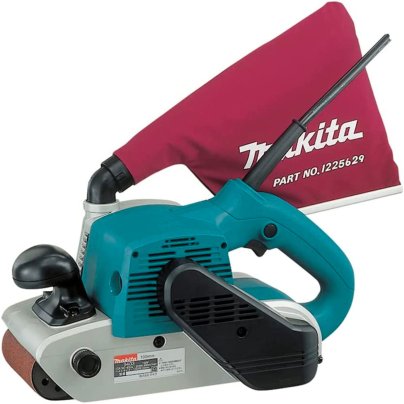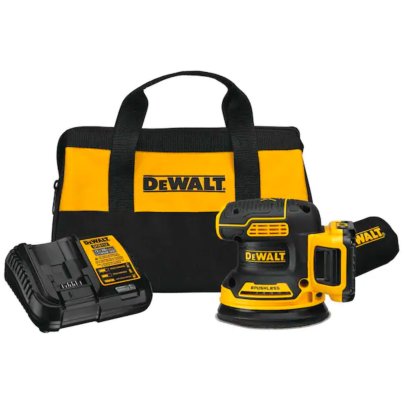
We may earn revenue from the products available on this page and participate in affiliate programs. Learn More ›
It’s possible to use just about any sander for hardwood floors, but some can involve a long, laborious, and uncomfortable process. As is usually the case, using the right tool for the job will make life a whole lot easier. However, with so many different sanders on the market, it can be difficult to know which kind to choose.
There are a variety of types of sanders, all with a specific purpose and each suited for different aspects of sanding hardwood flooring. The key to choosing the best sander for hardwood floors is understanding how each tool performs.
Keep reading to find out the physical and technical aspects of some of the best sanders for hardwood floors currently on the market, find out answers to a number of the floor-sanding questions that often crop up, and learn about some sanding tips that will help produce a more professional result.
- BEST OVERALL: Makita 4-Inch by 24-Inch Belt Sander
- BEST BANG FOR THE BUCK: Skil 3-Inch by 18-Inch Belt Sander
- MOST VERSATILE: DeWalt Cordless Orbital Sander Kit
- BEST DETAIL: Wen Cordless Palm Sander
- BEST UPRIGHT: Zelcan Drywall Sander With Vacuum Attachment
- BEST PROFESSIONAL: Powr-Flite Orbital Floor Machine

Before You Buy a Sander for Hardwood Floors
DIY floor sanding can take several forms. Those repairing a small area may already own a general-purpose sander that will do the job. Generally speaking, though, whether one is laying a new floor or stripping and refinishing an existing one, the area can be quite large. Any machine to sand wood could be used to tackle the job, but many will result in the DIYer spending all day on their hands and knees.
While our list of top sanders for hardwood floors offers a variety of tools to make the job quicker and easier, the fastest is undoubtedly an industrial floor sander. Although heavy, these industrial tools are used standing up and are much more comfortable to use. Unfortunately, even the cheapest options cost thousands of dollars. The good news is that these sanders can be rented, and many big-name home improvement retailers offer this rental service.
It’s also important to do the math before investing in (or renting) a floor sander. DIYers who need to rent one for several days may find that the cost can soon add up to more than the price of buying a small floor sander. Most of these small sanders will take longer to sand a floor, but all of our picks are multipurpose tools that can be used for other jobs. Nevertheless, renting floor sanding equipment is certainly an option worth considering.
How We Chose the Best Sanders for Hardwood Floors
I’ve been a keen DIYer for many years. I’ve done bare-bones remodeling on two of our homes, and for over a decade I owned my own woodshop. I have real-world experience with many different types of sander, and I know what to consider when working on hardwood floors.
In addition to my personal experience, the Bob Vila team researched dozens of different tools, comparing price and performance to find those that best meet the needs of typical DIY users. We also wanted to ensure that they offered lasting value. Long-term reliability was important, but so was versatility. Not a single one of these tools is solely for sanding floors; they can all tackle other tasks around the home.
Our Top Picks
The following list offers a hardwood flooring sander for most every need and budget. Each has been assigned a category so buyers can quickly find the right tool whether they are repairing a small section of floor or working through an entire house of hardwood floors.
Best Overall
Makita 4-Inch by 24-Inch Belt Sander
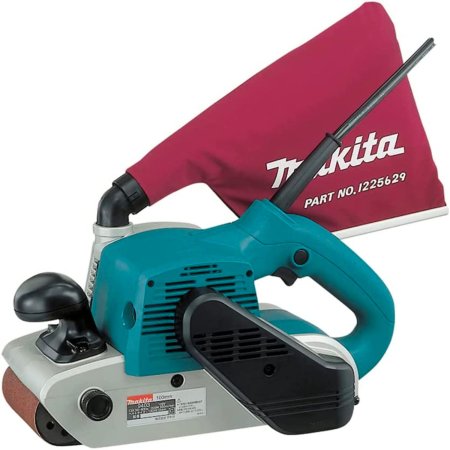
Pros
Cons
Product Specs
- Power: 11 amps; corded
- Sanding surface: 4-inch-by-24-inch belt
- Dust collection: Soft bag
The Makita belt sander offers an ideal balance of features for most DIYers. It has a powerful 11-amp motor to tackle large floor areas, but it lacks the astronomical price of commercial floor sanders. It can also be used to sand beams, decks, doors, tables, or any other substantial woodworking project.
The 4-inch-by-24-inch belt and 1,640 feet-per-minute speed deliver remarkably rapid material removal. The substantial footprint makes for a stable platform so it’s easier to keep floors even. The design is open on the right hand side, allowing sanding flush to the wall, and a single lever makes for quick and easy belt changing. At 84 decibels, it’s also quiet for a sander with this level of performance.
The Makita 4-inch-by-24-inch belt sander is renowned for its reliability, and problems are almost unknown. However, while the chunky handles allow for good control, this powerful machine weighs 13 pounds and it does pull quite strongly. For this reason, it can be tiring to use for long periods.
Get the Makita sander for hardwood floors at Amazon, The Home Depot, or Acme Tools.
Best Bang for the Buck
Skil 3-Inch by 18-Inch Belt Sander
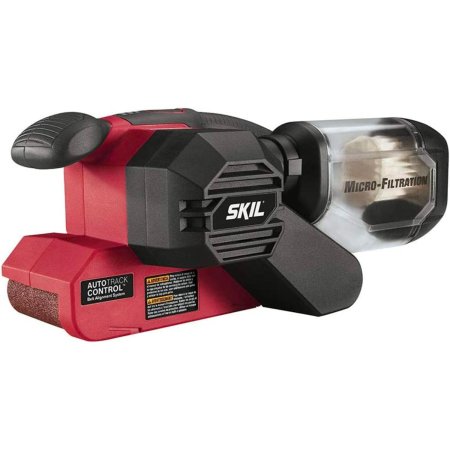
Pros
Cons
Product Specs
- Power: 6 amps; corded
- Sanding surface: 3-inch-by-18-inch belt
- Dust collection: Micro-filtration canister
Belt sanders are the best tool for rapid material removal, but the size and power of some can make them difficult to manage. With its 6-amp motor, the 3-inch-by-18-inch Skil still delivers competitive performance, but its 6.4 pounds makes it lighter and more maneuverable than many.
Pressure is monitored for optimum performance with red, yellow, and green LEDs. Keeping it in the green provides the best finish. It filters fine dust so it doesn’t get into the air, and the clear canister makes it easy to see when it needs to be emptied. Auto tracking ensures the sanding belt doesn’t stray, and changing it involves a single lever operation.
The Skil belt sander is a popular tool. Faults aren’t common, but some feel the filter clogs too easily, and there are a few reports of motor failures caused by overheating.
Get the Skil sander for hardwood floors at Amazonor The Home Depot.
Most Versatile
DeWalt Cordless Orbital Sander Kit

Pros
Cons
Product Specs
- Power: 20V; cordless
- Sanding surface: 5-inch-diameter pad
- Dust collection: Soft bag
Random orbital action is used by many of the best industrial floor sanders because it removes material quickly while minimizing scratches. The DeWalt cordless sander uses the same principle, but on a smaller scale. The 5-inch-diameter sanding head means it can cope with large areas, but it’s compact and light enough for a host of other sanding tasks such as stripping paint, sanding filler or putty, and doing general woodworking.
Cordless power makes the DeWalt sander portable, and the ergonomic rubber grip makes it easy to handle. A brushless motor maximizes battery efficiency and runtime. Additionally, the included charger and useful carry bag make for a competitively priced kit.
The DeWalt orbital sander provides outstanding reliability, and it’s difficult to fault. However, the 2Ah (amp hour) battery will restrict working time somewhat unless a spare is added, which increases the overall cost.
Get the DeWalt sander for hardwood floors at Amazon, The Home Depot, or Acme Tools.
Best Detail
Wen Cordless Palm Sander
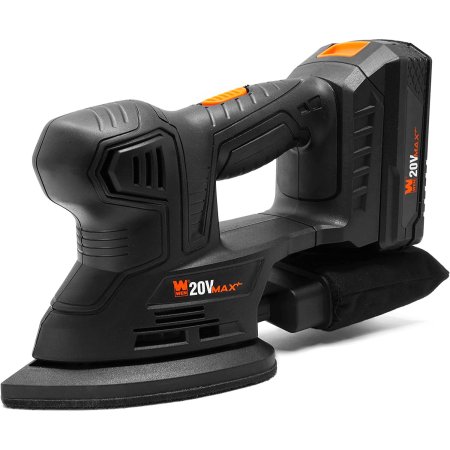
Pros
Cons
Product Specs
- Power: 20V; cordless
- Sanding surface: 3.75-inch-by-5-inch pad
- Dust collection: Soft bag
Even dedicated-edge floor sanders struggle around doorway moldings or around fixtures like toilets and tubs. That’s when a small hand floor sander like this cordless model from Wen comes into its own. The 3.75-inch-by-5-inch triangular pad can handle intricate detail, and it’s ideal for refinishing small areas of flooring. It can also come in handy for lots of DIY and woodworking projects.
The Wen palm sander might be small, but the 20V battery means it has plenty of power. There’s a useful LED charge gauge built in, and an ergonomic dual-grip handle provides maximum control.
While it is not a tool for sanding large areas of hardwood floor, it would be a great companion to a belt sander. The budget-friendly price makes it an affordable addition to any tool kit.
Get the Wen sander for hardwood flooring at Amazonor The Home Depot.
Best Upright
Zelcan Drywall Sander With Vacuum Attachment
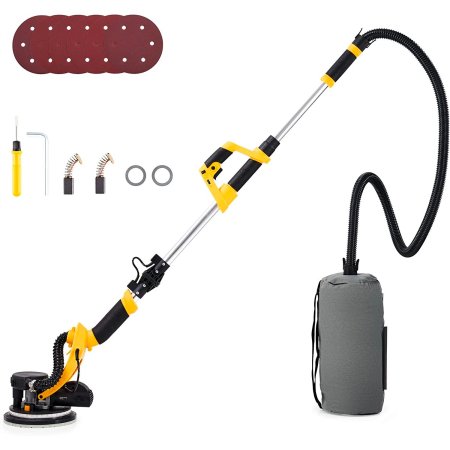
Pros
Cons
Product Specs
- Power: 800W; corded
- Sanding surface: 9-inch-diameter pad
- Dust collection: Vacuum bag
The big advantage with commercial sanders for hardwood floors is that the user can stand upright. However, added comfort comes at a higher cost. This Zelcan model offers an interesting and very competitively priced alternative. Although it’s sold as a drywall sander, it can also be used for floors with the right sandpaper.
The telescopic handle has a reach of between 59 and 71 inches, so it can adapt to users of different heights. There are six speeds between 500 and 1,800 rotations per minute (rpm), and lower speeds are typically used for hardwood. The 9-inch-diameter head provides efficient sanding of large areas, and it has a removable section for edging. Additionally, a large vacuum bag provides efficient dust collection.
While the majority of owners seem to be happy with their purchase, there have been reports of drive failures where the motor runs but the head doesn’t rotate. Also, although rips aren’t common, a few feel the vacuum bag should be tougher.
Get the Zelcan sander for hardwood floors at Amazon.
Best Professional
Powr-Flite Orbital Floor Machine
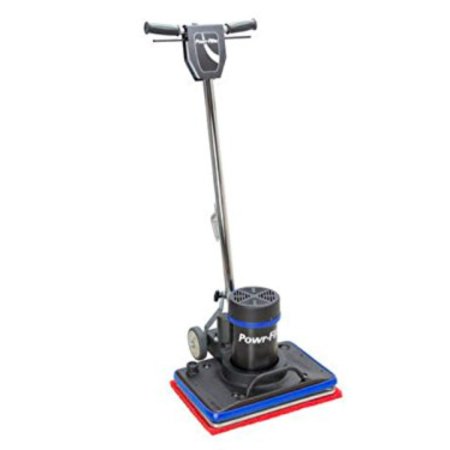
Pros
Cons
Product Specs
- Power: 1.5 hp; corded
- Sanding surface: 14-inch-by-20-inch pad
- Dust collection: No built-in collection; shop vacuum can be used
The Powr-Flite is a multifunction tool with a powerful, fan-cooled 1.5-horsepower motor that drives a 14-inch-by-20-inch orbital pad. The choice of pad defines function. In addition to sanding, it can be used for cleaning, buffing, or polishing. A pair of optional weights can be added to increase sanding pressure if required. Wheels with rubber tires make it easy to move the orbital floor sander around. With a noise level of just 69 decibels, it’s relatively quiet for tools in this category, too.
There is no built-in dust collection, but a dust port allows a shop vac to be attached. Although the Powr-Flite costs less than most other industrial sanders for hardwood floors and provides great versatility, it is likely too expensive for many beginners or for casual usage.
Get the Powr-Flite sander for hardwood floors at Amazon.
Jump to Our Top Picks
Types of Sanders for Hardwood Floors
Sanders for hardwood floors come in a number of different configurations, including DIY to commercial floor-sander options, and each has its pros and cons. While this section describes each type, similar principles apply to many of the smaller tools listed in our top picks. We’ve made comparisons where relevant.
Drum
Drum sanders are heavy-duty machines that are popular with professionals and rental companies. They use the same principle as a belt sander, but in a large and upright form. They usually have very efficient vacuums with large bags for dust collection.
These types of sanders can remove a lot of material very quickly. As a result, they are great for sanding rustic floorboards or for removing thick varnish. In skilled hands, a drum sander for floors can cover large areas more quickly than any other type. However, since they can be aggressive, inexperienced users need to be careful.
While using a drum sander, It’s important to keep it moving. Too much time spent on the same spot will cause depressions that are difficult to rectify.
Orbital Vibrating
The action of an orbital vibrating floor sander is similar to that of DIY handheld orbital tools, though the commercial versions are upright. A motor produces both rapid vibrations and a random orbital motion. Heads are either round or square and have an abrasive that’s held on either by clamps or by hook-and-loop fasteners.
Orbital vibrating floor sanders don’t remove material quite as quickly as drum sanders, but they are usually easier to control. They may also be multifunction machines and are often recommended for sanding exterior decks that are made of softwood. A change of pad allows many orbital vibrating sanders to buff hardwood floors or polish tile and marble.
Edge
As the name suggests, a floor edge sander is a tool that can sand right up to walls or baseboards. These are much more compact than either drum or orbital sanders, usually measuring between 12 and 18 inches tall with a sanding disc between 7 and 12 inches wide. In addition to a floor edge sander’s ability handling edges, the size of this type of sander makes it useful for sanding hardwood floors in tight spaces such as bathrooms and utility areas.
Despite being smaller than other professional tools, they can still weigh around 50 pounds so they’re much heavier than DIY alternatives. It is also necessary to bend over to use them, so users may need to take periodic breaks to avoid backache.
What to Consider When Choosing a Sander for Hardwood Floors
Brand reputation and cost can have major impacts on the choice of sander for hardwood floors. While both of these issues are important in terms of expected reliability and overall value, it’s perhaps more important to focus on the key performance issues first, and then shop for tools that meet those requirements.
Power
Floor-sander power usually reflects the type of work the tool is expected to do. Commercial models typically have motors between 1 and 1.5 horsepower, and they can sand continuously for hours at a time. Belt sanders, the most powerful of the handheld models, have motors rated in amps, and a minimum of 6 amps would be ideal for DIY work. Cordless tools are rated in volts (V), and 20V models are recommended rather than lightweight 12V models that might bog down too often.
Speed tends to vary with the size of the machine. Professional floor sanders might seem comparatively slow, but they don’t need to be fast to be effective. Confusingly, belt sanders will often be rated in feet per minute, whereas rpm is used to rate detail and orbital sanders. This makes comparisons practically impossible.
Complicating comparisons further, some sanders have variable speed and many are fixed. Variable-speed sanders can be useful when switching from hardwood to softwood, but otherwise it’s not particularly important. Most people tend to run their sander at full speed anyway, which is perfectly acceptable.
Size
While it might seem obvious that a large floor sander will cover a particular area more quickly than a smaller model, choosing the bigger tool isn’t always best. For instance, large commercial sanders often weigh more than 100 pounds, and it takes a degree of physicality to muscle them around.
Big upright machines are great for wide open spaces, but they can be impractical for small rooms. Even edge sanders are quite bulky. For those refinishing a bathroom, for example, and not wishing to move existing fixtures such as the toilet, a small detail sander can be invaluable.
Shopping for a Used or Refurbished Sander for Hardwood Floors
While many people may balk at the idea of spending money on a secondhand tool, a refurbished sander can be a win-win situation. It cuts down on waste and it gives buyers the opportunity to acquire products that might otherwise be outside their budget.
Plus, today’s refurbished models are not the dubious equipment often found at neighborhood yard sales. Reputable manufacturers and retailers frequently offer high-quality refurbished sanders alongside new models.
Unlike tools that have been beaten to death and then returned on the day the warranty expires, often refurbished sanders have been tried and then returned within a relatively short time. They might also be tools that are in torn packaging or have only cosmetic damage.
So are refurbished flooring sanders any good? In our opinion, yes. There’s every chance they could represent an attractive bargain. However, care and common sense is needed when shopping.
- Specify the type of floor sander you want, and look at new models. Then see what you can get on the refurbished market that comes close to those specifications.
- Keep a tight rein on your budget: It’s easy to get carried away. The idea here is to save money or get a better value.
- Look for a substantial cost reduction. If the savings is only 10 or 15 percent, it might be better to buy new.
- Make sure you know exactly what is included. Cordless tools often won’t include a battery or charger, for example.
- Be sure to check the warranty and return periods before you order. Don’t make assumptions, even if you’ve purchased from the retailer before.
While refurbished, reconditioned, or renewed tools are often excellent, there’s always a chance that a tool could be a dud. Buy from a reputable source like Amazon Renewed or Walmart Restored, and check the floor sander as soon as it arrives so you can get your money back if there’s a problem.
Tips for Using a Sander for Hardwood Floors
Whether the user is a beginner or moderately experienced, some tips for using a floor sander can prove quite useful. Here are a few specifics worth mentioning when it comes to using a sander for hardwood floors.
- It’s important to take adequate safety precautions. Getting wood dust in airways and lungs is uncomfortable at best, but it can cause serious respiratory problems. Always wear a dust mask and eye protection. Ear protection is also a good idea. Each of the tools in our top picks either has integrated dust collection or can have a vacuum attached. Empty them regularly to maintain efficiency.
- Those who haven’t used a particular type of sander will want to read the instructions carefully before starting. It’s particularly important to know how to turn the machine off quickly. Whenever practical, it’s a good idea to practice on a scrap piece of wood or an inconspicuous area.
- Learn about the different grades of sandpaper. Abrasives have different levels of grit from coarse (low numbers) for removing material quickly to smooth (higher numbers) for finish sanding. Tool manufacturers and rental companies can usually provide guidance on what will work best for their machine on the type of hardwood being sanded.
- Plan your approach to the task and decide where you intend to start and finish. Consider any obstacles or difficult areas. Fatigue is one of the biggest causes of problems when sanding, so take regular breaks and stop for the day if tired. The floor will still be there tomorrow.
FAQs
There is a lot to learn about the variety of sanding power tools available for hardwood flooring, and you may have a few lingering questions. Below are answers to some popular questions about the best sanders for hardwood floors.
Q. How many times should I sand hardwood floors?
The number of times a hardwood floor needs to be sanded will depend on what you’re trying to achieve. If an existing finish is being removed, then at least one pass (and possibly two) will be required. A third and fourth pass might be needed to make the surface smooth enough for finishing.
With new bare-wood floors, it will depend on the condition of the hardwood. One pass may be sufficient for high-quality flooring, but more may be required if rustic boards are used. Generally speaking, the aim is to remove any roughness and machining marks or swirls that would spoil the finish.
Q. How long does it take to sand a hardwood floor?
This is one of those “how long is a piece of string” questions. There are all kinds of variables that will affect how long it takes to sand a hardwood floor. The initial condition and the intended final appearance have a major impact, and so of course will the size of the area being sanded. Then there’s the size and type of sander being used. What’s most important is to allow plenty of time to prevent the risk of accidents.
Q. What is the best way to sand hardwood floors?
With any sanding process, it’s always a good idea to work in the direction of the wood grain. This helps reduce visible scratch marks. In most cases, it is recommended to start with sandpaper of around 35 grit, then move through a medium 60 grit to perhaps 100 grit.
However, when working with new wood that is reasonably smooth already, the initial grit may not be required. Move the sander up and down the room in the direction of the boards. Overlap each pass by a couple of inches so no patches are missed.
Q. Do I need to buff hardwood floors after sanding?
The key to a good finish when sanding hardwood floors is removing as much dust as possible before applying wax, sealer, or varnish. A lot of dust remains in the air immediately after sanding, and it will settle out over a 24-hour period. Therefore, vacuuming immediately after and then a day later is a good idea.
Buffing shouldn’t be required until after the final finish has been applied and allowed to dry and cure for the period specified by the manufacturer. Buffing can then give a shine to the floor and bring out the natural warmth of the hardwood.
Woodworking expert and product specialist Bob Beacham has been writing consumer advice articles for national publications for more than a decade. He covers a wide variety of DIY, home, and garden subjects and is known for providing information that is thorough yet easy to understand.
